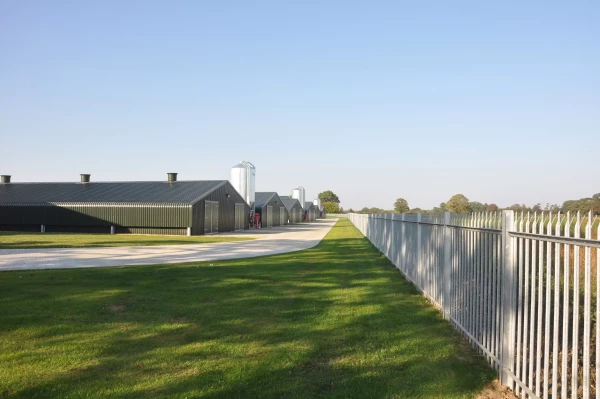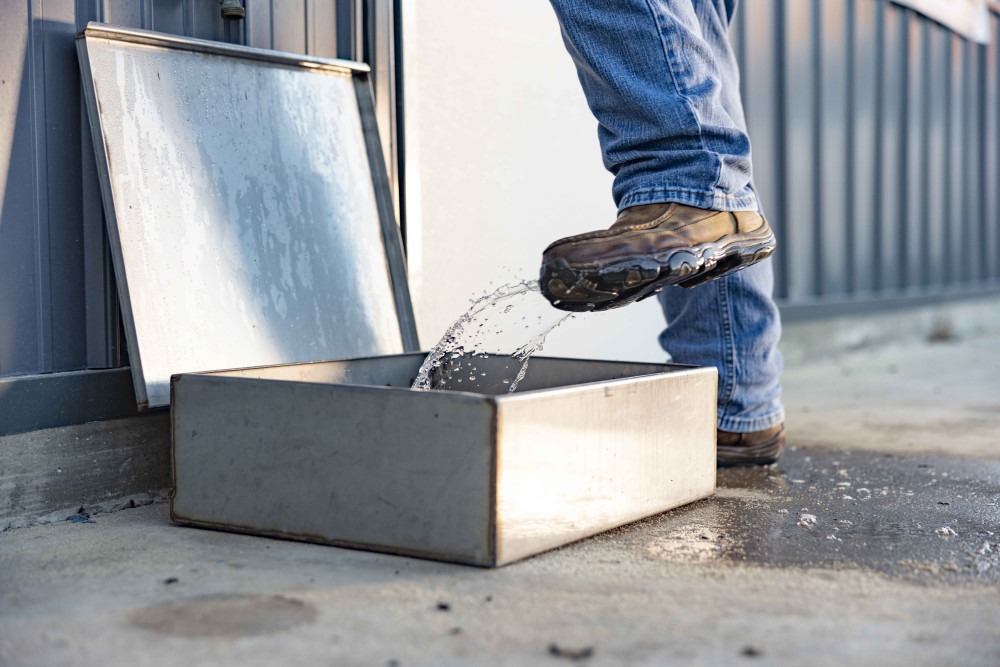By Andre Derkx, Cobb Europe
By definition, biosecurity involves the infrastructure and measures to prevent introducing and/or spreading a biological, chemical or physical agent to a susceptible population or individual. It not only applies to viruses, fungi and bacteria but also to chemical and physical components like dioxin or metal. A metal detector in a processing plant is itself part of a biosecurity system.
Basic farm set up
A farm or complex is generally divided into three sections. First there is the ‘black area’, the outside world with risk factors of the local environment. Then there is the ‘grey area’. There should be a clear demarcation between the black and grey areas, usually with a fence and a gate between them. There should be a foot dip or preferably a footwear change and dip on the border. Cars should either stay on the black side or have proper wheel disinfection. Be sure to use a disinfectant active against most pathogens, effective in the presence of organic material and active under the local outdoor temperatures.
Third and most important is the ‘white area’. Moving from a grey to white area needs a shower with change of clothes and footwear. No tools, equipment or mobiles should move from grey to white unless disinfected. Ultra-violet disinfection boxes are often used for these products, but be sure you use the right light and protective bottom and side plates should be of the correct material. You cannot just use normal (plexi) glass. High-volume products such as bedding material and feed need a different approach. Where farms cannot impose a full programme, there should be at least a change of clothes and footwear, and hair cover.
Avian influenza outbreaks have shown that biosecurity is not just a farm activity but a necessity for the global industry. The recent massive and widespread cases of H5N8 call for a strict biosecurity approach from all poultry keepers. It does not matter if you have ducks, chickens, pigeons, quail or falcons – we must all do this job together.
Farm location
With restrictions from different administrations, it is often difficult to build a new farm on a favored remote site. Ideally such an area with a low poultry and avian wildlife population is preferred. Water supply is one critical factor. The Total Dissolved Solids (TDS) can be critically important and will depend on the borehole location. The climate also influences the challenges, with hot dry climates having a much lower bacterial and fungal pressure compared to hot humid climates. Coryza is not an issue under the hot and arid conditions, but when hot and humid you will find it everywhere. Rain works as a cleaning shower, taking dust and with that viral particles out of the air. In an arid area the horizontal spread of viruses is huge despite a burning sun. The presence of vermin is often forgotten but can be critical.
Single versus multi-age makes a huge difference in performance. Some complexes still have parent stock, feed mill, broilers and processing on one location which makes biosecurity more difficult. Strict zoning of such a complex helps.
Transport
Transportation is a critical factor in moving diseases around. Vehicles often move from farm to farm, and it is best is to have a physical barrier between the black and grey areas so that trucks deliver to storage facilities in the grey area. Dedicated farm vehicles can then take care of movement within the white area. If a truck has to enter the white area, the driver should change footwear and use a coverall and hairnet and, if possible, take a shower. The truck should be disinfected or at least have a wheel and wheel arch disinfection. For feed trucks, if a filling pipe is needed, this should be farm dedicated.

If a truck has to enter the white area, the driver should change footwear and use a coverall and hairnet and, if possible, take a shower. The truck should be disinfected or at least have a wheel and wheel arch disinfection.
Employees can make or break effective biosecurity. Living on site in the grey areas is the preferred option, with a shower and disinfection barrier between the white and grey area.
Feed deliveries by overpressure systems are an extra risk since they take a lot of air from outside to deliver feed to a silo. This air comes from the farm environment and can easily contaminate the inside of a lorry and the filling pipe. After a delivery, lorries should be disinfected before going to the next farm.

If a truck has to enter the white area, the driver should change footwear and use a coverall and hairnet and, if possible, take a shower. The truck should be disinfected or at least have a wheel and wheel arch disinfection.
Employees
Employees can make or break effective biosecurity. In some countries, the risk of cross contamination by visiting backyard poultry is huge. Living on site in the grey areas is the preferred option, with a shower barrier between the white and grey area. A common canteen for all employees is a real risk factor: food supplied to the white area or re-showering when entering the white area should be adopted. The rule for visitors and third party employees is ‘Not allowed in the white area unless necessary’. Biosecurity guarantees must be in place. A visitor logbook explaining the rules should be provided. Where shower facilities are not available, only one farm visit per day must be the standard. A good way to reduce visits is to carry out preventive maintenance when the house is empty.
Disinfection and downtime
Cleaning should include following components as a minimum:
- When a house is depleted, an insecticide should be applied immediately.
- A dry cleaning phase where all dirt and dust is removed and equipment dismantled.
- A wet cleaning phase with an appropriate detergent which breaks down fat and protein.
- A disinfection phase; wet and/or gas. Have a minimum temperature of 20oC when most disinfectants are effective. Place equipment as well as floor coverage material such as shavings, rice hulls or straw inside the house before disinfection.
- Spread floor material after heating up a house when day-old chickens are to be placed.
- Have a quality assurance system in place to check bacterial counts after disinfection. Downtime is the period between the last disinfection and first placement of birds. On big farms this is often negative, with day-old chicks already in one house while others are still not disinfected. Aim for a minimum of three days when a farm is really clean and disinfected.

Employees can make or break effective biosecurity. Living on site in the grey areas is the preferred option, with a shower and disinfection barrier between the white and grey area.
Vaccination programmes
Vaccinations are part of your biosecurity programme and should be tuned to the local disease pressure and legislation. Separate vaccination equipment should be present on each farm. More broiler vaccinations are being done at the hatchery, reducing disease risks by vaccination teams. The ultimate goal is to supply a fully vaccinated day-old chick to the broiler farm. Biosecurity is something you all do together. Set up a good programme which all understand and follow. Remember that motivation is key to success in keeping the farm biosecure.


